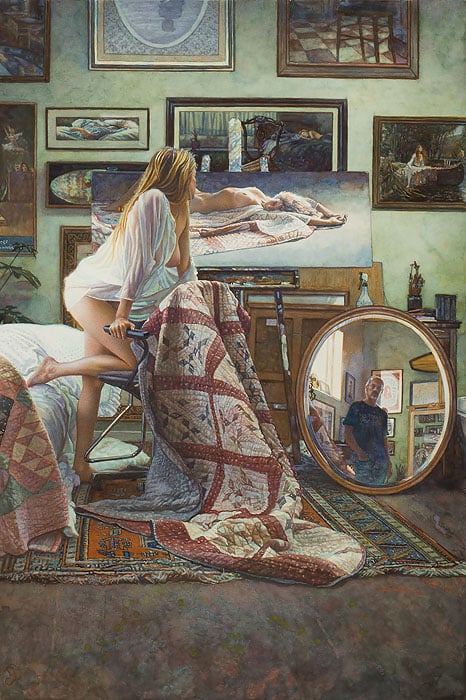In the Artist’s Studio
At its essence, Steve Hanks' art is about the beauty in life: the innocent loveliness of infants and children, the bond between mother and baby, the physical beauty of the female form in light and shadow, in stillness and in dance. The composition of a Hanks painting serves the emotion he sets out to paint, whether it be a vertical or horizontal canvas, the mystery in a woman facing downward, or how the upward tilt of a chin exudes confidence, the freedom of a girl’s spiraling limbs on a beach, or a young woman’s steady gaze at the wide horizon ahead of her.
Hanks was a figurative painter and for the most part the landscapes and room interiors were used for context not substance, although he included quilts and rug and floor patterns for depth and texture. The deeper the emotional landscape of his subject that he wanted to express, the vaguer the location. The complete expression of the figure was his way of saying, “This is where you are in the world.”
That said, Aspen, Colorado was an often-painted family vacation favorite, as well as New Orleans and Charleston, whose wrought iron and architecture and heavy green vegetation appealed to the artist whose home studio was in high desert. Steve Hanks lived most of his life in landlocked Albuquerque but his heart was near water. Contemplative figures were sometimes painted near shimmering lakes and rivers but the Pacific Ocean is where both pure joy and the complications of relationships played out in his art
In the fall of 2014, Hanks painted a rare self-portrait in his studio. It is uncharacteristically layered and complicated, befitting its subject. In the painting, there are reflections of reflections and he includes the tools of his trade and the studio artifacts that surround him. The life model, perched on the artist’s chair, studies her portrait on the easel. The tumbling quilt and her leg convey the tall verticality of the painting, yet the horizontal portrait and the framed art on the wall keep the eye focused on the center of the painting. The artist has stepped away from the easel and is framed in the circular mirror. What is he studying? The model, the painting, the life? In the mirror, above his head to the right, is the leading edge of a surfboard and below that, another mirror and within that, the reflection of the artist in the circular mirror and so on.
Steve Hanks’ "In the Artist’s Studio" is something special for his collectors and fans. Far more than a sneak peek into his workspace, it is a gem of a multi-layered autobiography. (The framed art on the studio wall is mostly his own. The checkerboard floor is Berkeley Kitchen, an acrylic from 1973. Did Steve find the image of John William Waterhouse’s The Lady of Shalott inspirational, or was there a personal connection he found to the character in the Tennyson’s poem that inspired the painting? A quick look into the story might reveal a whole other level in Hanks’ portrait to you.

